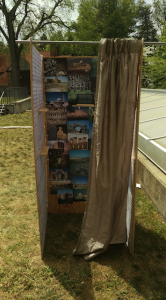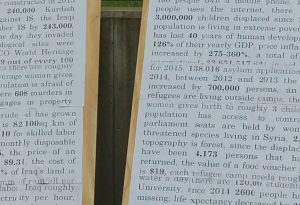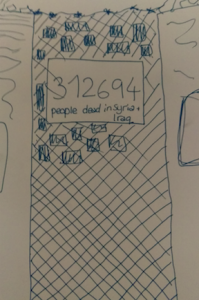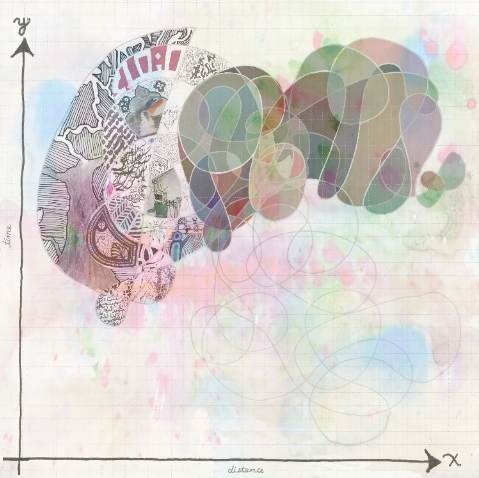

When I began with this installation project, I was very daunted by both the size, and the pressure to deliver such a poignant message. My installation hopes to “overwhelm by fact”. Once you enter you are faced with a monitor that has numbers that are moving at a rate of three digits per minute, which reflects the number of people that are becoming refugees. This is based approximately on recent refugee toll consensus. Behind the numbers are pictures of the many important historical and cultural sites that were bombed by the IS in Iraq and Syria. To the left is Iraq, to the right Syria. The backgrounds of both walls are statistics: good, bad, mundane, everything I could find, statistics to us have become numbers, the idea is to make you notice that you don’t care anymore. In front of these statistics will be screens playing videos- videos of violence, dance, poetry, war, culture: life. Life still goes on despite war, statistics can help us forget that and other the victims of war and injustice, let me now overload you with all the images you half pay attention to all day, maybe then, you will be affected.



As a design piece, my installation proved many challenges. I was originally planning on using the metal structure that the visionaries used in their sculpture, when visiting their site and walking through their space I was really inspired by the idea of being enveloped by art, on all sides, the potential for delivering maximum affect. But with circumstances of Formal and rain, I had to consider other options for my base structure. My solution turned into an attempt at carpentry that went better than expected. I was at first worried about my ability to be able to use tools for the carpentry process, however I became very rudimentary in my design and reverted to nails and hammers for the construction of the entire structure. The biggest struggle came when I realized that Home Depot only cut straight lines and couldn’t make cutouts in my wood pieces—this was a problem because I needed spaces for the wires to connect the LCD screens to the power source and computer. This caused a drastic shift in my thinking: I discarded the LCD monitor idea and decided to go with tablets. After being able to recruit enough friends to lend me tablets, I was able to then puncture holes with a screwdriver just big enough for the small chargers to go through. I was then left, with one more challenge. I had thought the easiest part was going to be making this ticking refugee toll, I was sorely mistaken. I soon learned that coding knowledge was needed for this, knowledge that I did not know. Through some pleading and favors someone from the coding class made me a program that would make the numbers increase, it apparently wasn’t that complicated. What became complicated however was that this program could only work on a computer… and my installation couldn’t support an LCD monitor anymore. I solved my last and final issue by finding by the grace of app makers an app that converts allows you to remotely control your computer through your tablet, thus allowing the coding program to open and be displayed! The process was tumultuous and stressful. From near-miss hammer and nail accidents to the logistical nightmare of moving it into Heimbold, I have gained both respect and admiration for the sculpture process, but have never more understood the danger of underestimating time.
I had never thought of mapping in such a physical and three dimensional way before both this class and the undertaking of this project. Even the basic physical lines of life represent a potential for signs and mapping, both visible and invisible. Through this project, I really hope to make you feel invisible—the life of the ordinary man Syria/Iraq—through bombarding you with the visible that we’re shown every day. The life that still goes on is a notion that the news likes to squash. Its like we want to believe when a country is at war, there is nothing else their citizens can be doing but “being at war”, but hey, look at that—divorce rates increased, I guess lawyers got more popular—but no one cares, right? Because war is numbers, deaths, dollars, drones, who cares Iraq’s unemployment rate finally improved?


